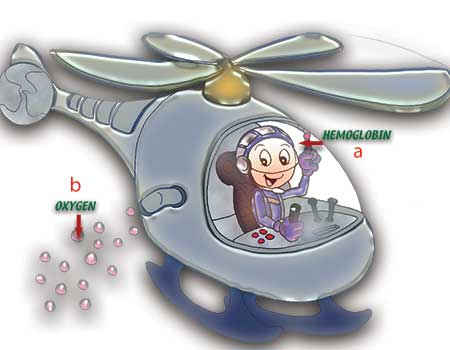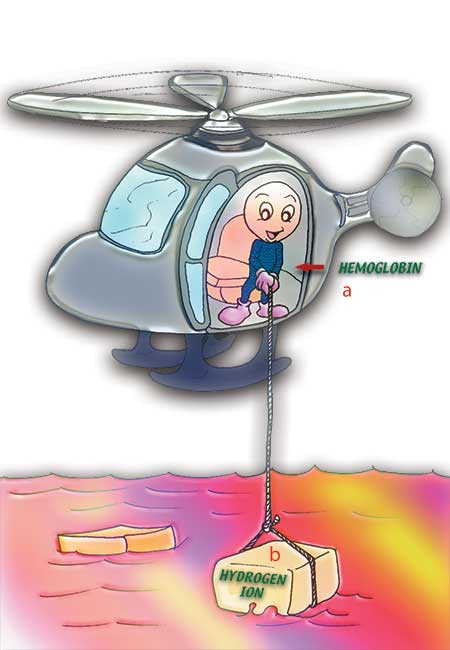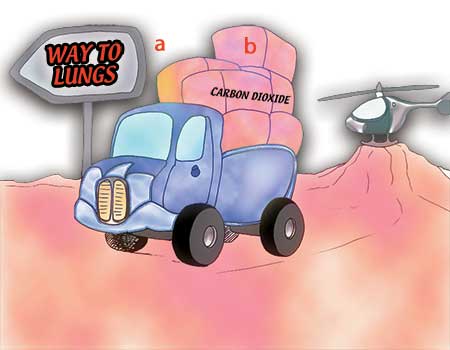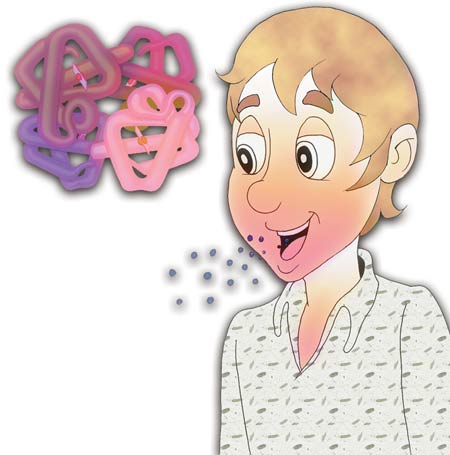17. Hemoglobin: The Miraculous Oxygen – Bearing Molecule
The main purpose of respiration is the expulsion of the carbon dioxide (CO2) from the body and its replacement by life-giving oxygen. These processes take place in a site far distant from the body tissues—in the lungs. That being so, the oxygen entering the body by way of the lungs needs to be carried to the tissues in some way, and the carbon dioxide forming in the tissues has to be removed from the lungs in the same way. How is that transportation carried out?
Erythrocytes, or red blood cells, are the tireless, indefatigable carriers of the oxygen and carbon dioxide in the blood. The erythrocytes that come into contact with the air in the lungs release their carbon dioxide—a waste product—they've brought from the cells into small sacs, and absorb the oxygen in those sacs. This process takes place along a very special membrane. One side of this membrane receives oxygenated air in the sac or alveolus, while on the other side, there are capillary extensions of such narrow width as to permit only one erythrocyte to pass. In this way, oxygen molecules has no difficulty in making contact with the erythrocytes.
 |
| a. Hemoglobin |
| Figure 73: Hemoglobin in the red blood cells releases the oxygen the cells need. |
The oxygen molecule is transported to the cells by a molecule inside the erythrocytes known as hemoglobin, which possesses a very special creation. In external appearance, it resembles a kind of donut with a thick membrane covering the central hole and is ideally suited to carrying both oxygen and carbon dioxide. Bonding to the oxygen molecules in the lung, hemoglobin sets out for the farthest parts of the body by way of the bloodstream. When it reaches the tissues that need oxygen, another miracle takes place. The hemoglobin molecule's very special design is affected by its chemical environment, and the chemical bond between it and the oxygen breaks. As a result, the hemoglobin deposits the oxygen molecules it is carrying, which permit life to continue in the surrounding cells (Figure 73.)
The duties of hemoglobin do not end here. It also plays an essential role in transporting the carbon dioxide that needs to be removed from its immediate surroundings. This phenomenon can be summarized thus:
The carbon dioxide produced by cell respiration passes from the cell to the tissue fluid, and from there to the capillary vessels. Part of the carbon dioxide combines with the hemoglobin in the erythrocytes and is transported away in the form of carbamino hemoglobin. The other part combines with water, under the influence of the enzyme carbonic anhydrase, to form carbonic acid, which later separates into bicarbonate and hydrogen ions. The emerging hydrogen ion is caught by the hemoglobin (Figure 74).
Carbon dioxide is thus carried from the capillary vessels through the larger veins and finally to the heart (Figure 75). From there, it is transported to the lungs. Following various processes that take place in the lungs, the carbon dioxide is expelled during normal exhalation, several times a minute (Figure 76).
 |
| a. Hemoglobin |
| Figure 74: The hydrogen ion released is held by the hemoglobin molecule, and carbon dioxide is thus brought to the lungs by way of the veins. |
There is another noteworthy feature in hemoglobin's structure. As well as being able to transport oxygen, it can also release the oxygen it carries at the right moment. The secret behind this ability lies in the chemical bond established between the oxygen molecules and hemoglobin.
To help you fully understand the importance of this property of hemoglobin the following analysis should be useful: If the bond established between hemoglobin were even slightly weaker, hemoglobin would not attach to the oxygen. Then oxygen molecules would fail to be carried to the tissues. This would mean inevitable death for any living thing. Were the exact opposite to occur—were the bond between hemoglobin and oxygen to be even slightly stronger—then the hemoglobin and oxygen would be unable to separate from one another upon reaching the tissues. The cells would again be deprived of oxygen, and the living thing would die within a matter of minutes.
 |
| a. Way to Lungs |
| Figure 75: Carbon dioxide reaching the heart is pumped from there to the lungs. |
These two facts represent evident proof of a special design inside hemoglobin—a perfect system that has been created for transporting oxygen inside the human body. Every detail within this system is just one of the countless proofs that display the infinite nature of the knowledge and might of God.
 |
| Figure 76: The carbon dioxide reaching the heart undergoes several processes before being expelled from the body by way of exhalation. The three-dimensional structure of hemoglobin is shown above. |
- Introduction
- 1. Monitors That Control the Level of Fluids in the Blood
- 2. The Body's Impeccable Security System
- 3. Mother's Milk and the Hormone Oxytosin
- 4. Calcium Measurers
- 5. The Sugar Factory
- 6. Emergency Assistance The Hormone Adrenaline
- 7. The Lysosomal Enzymes That Purify the Body
- 8. The Flowless System That Regulates Blood Pressure
- 9. Growth Hormone
- 10. The Clock in Our Bodies That Never Goes Wrong
- 11. The Miraculous Molecule That Regulates Body Temperature
- 12. An Extraordinarily Delicate Balance
- 13. Hormones That Prepare the Way For the Baby -1
- 14. Hormones That Prepare the Way For the Baby -2
- 15. The Hormones in the Male Reproductive System
- 16. Other Properties of the Hormone Testosterone
- 17. Hemoglobin: The Miraculous Oxygen – Bearing Molecule
- 18. The Communications System in the Cell
- 19. The Messenger Hormone's Journey within the Cell
- 20. Communication Control in the Cell
- 21. Protein Traffic within the Cell
- 22. Chemical Communication in the Nerve Cell
- 23. Nitric Oxide: A Skilled Messenger
- 24. The Endothelial Cell: A Nitric Oxide Production Center
- 25. The Power Station in the Human Body
- 26. The
- 27. DNA Replication
- 28. Repair Enzymes
- 29. Protein Production
- 30. The Final Stage of Protein Production
- 31. The Cell Membrane and 100 Trillion Organized Workers
- 32. What Happens at the Moment of Hearing?
- 33. Blood Clotting
- 34. The Immune System
- 35. The Journey of Vitamin B12
- 36. The Pancreas: The Human Body's Chemist
- 37. Transporter Molecules in the Cell Membrane
- 37. Complement Proteins Responsible for Protecting the Body
- 39. Anti – Acid Formulas Producing Molecules
- 40. The Consciousness Displayed by Egg Cells
- Conclusion
